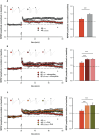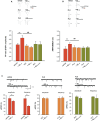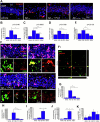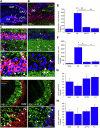Switch to phagocytic microglia by CSFR1 inhibition drives amyloid-beta clearance from glutamatergic terminals rescuing LTP in acute hippocampal slices
- PMID: 39179543
- PMCID: PMC11344079
- DOI: 10.1038/s41398-024-03019-2
Switch to phagocytic microglia by CSFR1 inhibition drives amyloid-beta clearance from glutamatergic terminals rescuing LTP in acute hippocampal slices
Abstract
Microglia, traditionally regarded as innate immune cells in the brain, drive neuroinflammation and synaptic dysfunctions in the early phases of Alzheimer disease (AD), acting upstream to Aβ accumulation. Colony stimulating factor 1-receptor (CSF-1R) is predominantly expressed on microglia and its levels are significantly increased in neurodegenerative diseases, possibly contributing to the chronic inflammatory microglial response. On the other hand, CSF-1R inhibitors confer neuroprotection in preclinical models of neurodegenerative diseases. Here, we determined the effects of the CSF-1R inhibitor PLX3397 on the Aβ-mediated synaptic alterations in ex vivo hippocampal slices. Electrophysiological findings show that PLX3397 rescues LTP impairment and neurotransmission changes induced by Aβ. In addition, using confocal imaging experiments, we demonstrate that PLX3397 stimulates a microglial transition toward a phagocytic phenotype, which in turn promotes the clearance of Aβ from glutamatergic terminals. We believe that the selective pruning of Aβ-loaded synaptic terminals might contribute to the restoration of LTP and excitatory transmission alterations observed upon acute PLX3397 treatment. This result is in accordance with the mechanism proposed for CSF1R inhibitors, that is to eliminate responsive microglia and replace it with newly generated, homeostatic microglia, capable of promoting brain repair. Overall, our findings identify a connection between the rapid microglia adjustments and the early synaptic alterations observed in AD, possibly highlighting a novel disease-modifying target.
© 2024. The Author(s).
Conflict of interest statement
The authors declare no competing interests.
Figures






References
-
- Yousefizadeh A, Piccioni G, Saidi A, Triaca V, Mango D, Nisticò R. Pharmacological targeting of microglia dynamics in Alzheimer’s disease: Preclinical and clinical evidence. Pharmacol Res. 2022;184:106404. - PubMed
-
- Prinz M, Jung S, Priller J. Microglia biology: one century of evolving concepts. Cell. 2019;179:292–311. 10.1016/j.cell.2019.08.053. - PubMed
-
- Paolicelli RC, Bolasco G, Pagani F, Maggi L, Scianni M, Panzanelli P, et al. Synaptic pruning by microglia is necessary for normal brain development. Science. 2011;333:1456–8. 10.1126/science.1202529. - PubMed
MeSH terms
Substances
LinkOut - more resources
Full Text Sources
Research Materials
Miscellaneous

